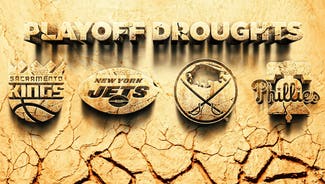
Hockey sticks no longer one size fits all

GLENDALE, Ariz. (AP) Hockey sticks used to come one size fits all. If players wanted a better fit, it required lots of do it yourself, cutting, sanding, heating and bending the stick into a shape and size that fit them.
That changed with the introduction of one-piece composite sticks. Now players get their sticks already custom fit, with precise specifications on everything from the curve of the blade to the shape of the shaft, ready to go right out of the box.
''They really don't have to do a whole lot when their sticks arrive,'' said Jason Rudee, an assistant equipment manager for the Arizona Coyotes for 15 years. ''Sticks have changed so much.''
In the early days of hockey (around the mid-1800s), sticks were made of wood, first from a single chunk, later with many layers of wood glued together to add flexibility.
By the 1950s, manufacturers began wrapping sticks with fiberglass for reinforcement. Players then started heating the synthetic materials on the stick and bent it, often by wedging it under a door. The sticks - known as banana blades - became so unpredictable and dangerous that the NHL quickly put a limit on the amount of curve a stick could have.
By the 1970s, fiberglass was used throughout the stick blades and shafts, making them lighter and more durable than ever before. After a stint of aluminum shafts in the late 1980s/early 1990s, composite shafts were introduced, offering the flexibility and stability of a wooden shaft with less weight.
The stick game changed forever with the introduction of the one-piece composite in the early 2000s. The one-piece composites are lighter, have stiffer blades and shafts that taper toward the blade, lowering the kick point.
With more whip, less weight and extra bounce off the blade, players hit shots harder than before and the game has sped up to keep up with the technology.
''The older you get, the more flex you want,'' Coyotes 39-year-old captain Shane Doan said. ''My elbows and wrists get sore when you get too stiff of a stick. It's kind of like golf: The older you get, the more whippy of a shaft you need.''
Nearly every NHL player uses a one-piece composite and a few goalies, who tend to prefer wooden sticks, have turned to composites.
And there is a dizzying array of variables to consider when picking out a stick.
There's length, amount of grip on the shaft, type of tape on the handle, flex, kick point, shaft shape (rounded or square), a knob at the end or not, lie and curve of the blade. There also numerous stick manufacturers, so if a player doesn't like one stick, he can try one from another stick maker.
The stick's lie is much like that of a golf club: The angle of the blade out of the shaft can be adjusted flatter or more upright depending on a player's height, stance and preference.
The curve is the most complicated aspect of the stick and most often the most important to players.
Though the amount of curve is limited by NHL rules, the twist-and-tilt combinations within it are never-ending. Some players like flatter sticks for hitting hard slap shots, others want more curve for better control. A player's curve is like a fingerprint, though some will borrow if they find something they like.
''I saw Erik Karlsson using it and it worked pretty good for him, so I decided to try it out and I really like this curve,'' Coyotes defenseman Oliver Ekman-Larsson said. ''It feels like it (the puck) comes off pretty quick.''
Hockey players also treat their sticks like baseball players with gloves or golfers with putters and drivers; some tinker constantly, others just grab what works and go.
''There are some guys who use the same one, they've used the same one for years,'' Rudee said. ''They may try something else, but if it's working for them, they stick with it. There are other players who may change with technology; the latest and greatest that comes out, they try it and like it better, move on to that one.''

